
Managing a small pond seems easy, until things go wrong. One of the misconceptions of managing a small pond, or any pond for that matter, is that once you get it where you want it, it will stay there by itself.
If you have a swimming pool, does it stay the same all year? No, it doesn't. Neither does the food in your refrigerator. Nor does your favorite vehicle. Face it, we have to maintain what we have.
But, once your mini-pond achieves what you want, how do you keep it there? First, you have to know when your pond is there, whatever that means to you.
Here's an example. A neighbor of ours, Mr. Lee, is a crusty fellow. He used to run the local water department and has farmed and ranched for much of his eight decades. He's got a mini-pond and doesn't tend to manage it. His strategy is to stock some catfish, feed them a little bit—very little, actually—and once they grow to two pounds, start catching them for the frying pan. That's a simple mission, and he doesn't feed many people. A hundred catfish fingerlings in that pond will grow up in a year to year and a half, and by that time, enough of the whiskered fish are big enough to fit his desires. He's a patient angler, with plenty of time. He'll catch some, eat them, catch a few more, freeze them, and do it again until his laws of diminishing returns kick in. Then, he'll set a trap and catch a few more, then restock with more fish. His status quo is two-pound fish, with different fish growing to size over two to four years.
Then there's a mini-pond that's a focal point at a high-end rural property where clients are entertained regularly. That pond is designed to be beautiful, with pristine water clarity and minimal aquatic plants. This Fish Bowl Pond is a regularly scheduled maintenance item on the ranch managers weekly checklist. Fish are stocked regularly to help prop up its balance, and water quality is regularly monitored. An expensive fountain with beautiful lights draws the eyes of visitors from the moment the pond comes into view.

What about yours? Want to keep it like it is? Then understand every decision and action you take will create a reaction. If you predict the reaction, you can manage for your status quo.
Here's another example. Next to our home is the swimming pond at LL,2. We use it for that, but we also feed the fish in it. There are some really nice fish, and most of our grandchildren caught their first fish off the dock. In the hottest part of the summer, Debbie loves to wrap herself with a life jacket, pour a glass of white wine, and just while away a boiling hot evening, talking and making plans.
Part of my job is to make sure that pond stays healthy. Ironically, I'm not too focused on the fish—-it's a swimming pond. The focus here is to keep the water healthy and vibrant enough to support the masses who wish to swim in it. So, when the pond was built, we installed an irrigation system where we draft water from about five feet off the bottom, and irrigate the lawns and garden with that water. Plus, we have a bottom diffused aeration system set about two-thirds to the bottom of the pond to keep water moving all summer. So, our status quo mission for this pond is to keep the water moving and healthy, so we can swim in it. The fish are thriving in it, and clarity is about where we want it. No chemicals are added, and we replace water pumped or irrigated from it with our well. It's a system that works for us. No one catches a huge fish, but kids can catch lots of fish. Most importantly, we can swim in it without worrying about how healthy or safe the water is.
That's pretty refreshing, in more ways than one.
The swimming pond is beautiful and we stay focused keeping the water happy and healthy.
Here's the concepts at work for you to consider. Mr. Lee stocks fish, feeds a little bit, watches his fish grow, and harvests them over a long period of time, relatively speaking. Then, he'll stock more fish. The Fish Bowl Pond needs constant attention to make sure the water is clear, fish are stocked, primarily because there are too many fish. That sounds a little goofy, but more fish are stocked to feed existing fish, plus give some new fish an opportunity to fit into this system and thrive. Then, there's the swimming pond. We harvest water, use it, and then replace it. Water left behind is constantly moved to let nature and the atmosphere do what it does.
The biggest lesson here revolves around understanding how your pond works, and then working with it to keep it like you want it. Don't assume you'll get it where you want it, and it will stay there by itself. By nature, your favorite pond will change. It's up to you to figure out how you want it to go, and then guide it.
The best news is that a mini-pond is easy, and not too expensive, to mold and guide where you want to keep it.



